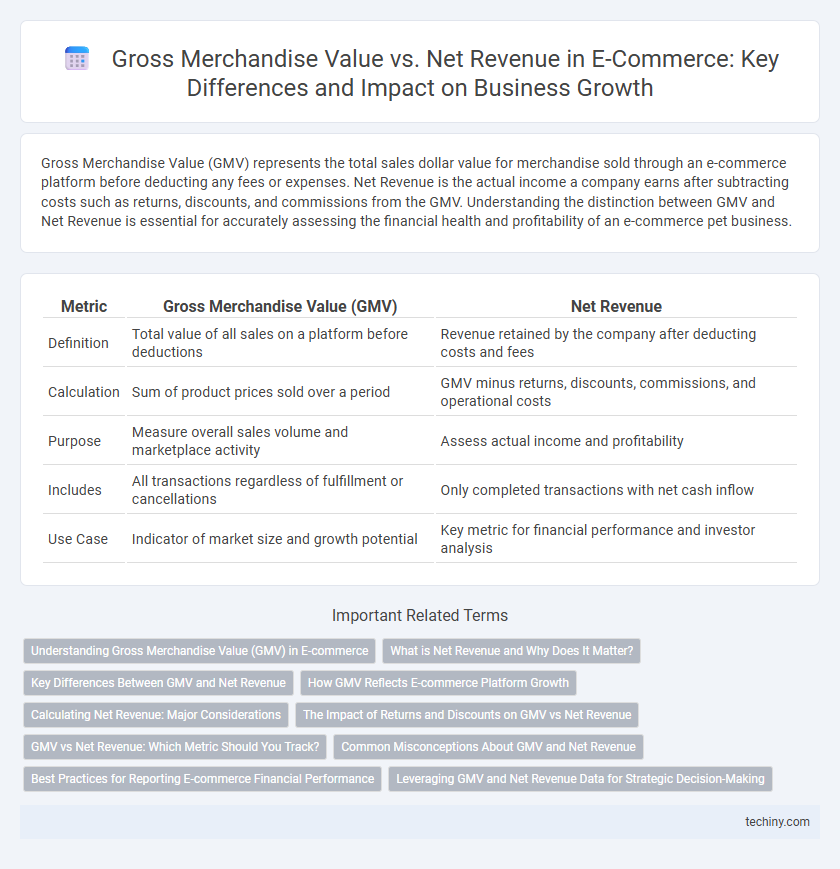Gross Merchandise Value (GMV) represents the total sales dollar value for merchandise sold through an e-commerce platform before deducting any fees or expenses. Net Revenue is the actual income a company earns after subtracting costs such as returns, discounts, and commissions from the GMV. Understanding the distinction between GMV and Net Revenue is essential for accurately assessing the financial health and profitability of an e-commerce pet business.
Table of Comparison
| Metric | Gross Merchandise Value (GMV) | Net Revenue |
|---|---|---|
| Definition | Total value of all sales on a platform before deductions | Revenue retained by the company after deducting costs and fees |
| Calculation | Sum of product prices sold over a period | GMV minus returns, discounts, commissions, and operational costs |
| Purpose | Measure overall sales volume and marketplace activity | Assess actual income and profitability |
| Includes | All transactions regardless of fulfillment or cancellations | Only completed transactions with net cash inflow |
| Use Case | Indicator of market size and growth potential | Key metric for financial performance and investor analysis |
Understanding Gross Merchandise Value (GMV) in E-commerce
Gross Merchandise Value (GMV) in e-commerce represents the total sales dollar value of merchandise sold through a marketplace over a specific period, excluding any deductions like returns, discounts, or cancellations. GMV measures the overall volume of transactions, providing insights into marketplace growth and customer demand but does not reflect the actual income earned by the business. Comparing GMV to Net Revenue highlights business efficiency, as Net Revenue accounts for fees, refunds, and operational costs, offering a clearer picture of profitability.
What is Net Revenue and Why Does It Matter?
Net revenue in e-commerce refers to the total income generated from sales after deducting returns, discounts, and allowances, providing a clearer picture of actual earnings. It matters because it reflects the company's true profitability and operational efficiency, unlike Gross Merchandise Value (GMV) which only measures total sales volume without considering associated costs or deductions. Understanding net revenue helps businesses make informed decisions on pricing strategies, marketing investments, and growth planning.
Key Differences Between GMV and Net Revenue
Gross Merchandise Value (GMV) represents the total sales dollar value for merchandise sold through an e-commerce platform over a specific period, including all transactions before deducting any costs or fees. Net Revenue refers to the actual income retained by the company after subtracting returns, discounts, platform fees, and other expenses from GMV. The key difference lies in GMV showing the overall transaction volume, while Net Revenue reflects the true profit-generating revenue stream of the e-commerce business.
How GMV Reflects E-commerce Platform Growth
Gross Merchandise Value (GMV) measures the total sales dollar value for merchandise sold through an e-commerce platform, serving as a primary indicator of marketplace activity and growth potential. Unlike Net Revenue, which accounts for costs and fees, GMV highlights gross transactional volume, reflecting customer demand and seller engagement on the platform. Tracking GMV trends enables investors and analysts to assess market expansion, platform scalability, and consumer adoption rates in real time.
Calculating Net Revenue: Major Considerations
Calculating net revenue in e-commerce requires deducting returns, discounts, and allowances from the gross merchandise value (GMV) to reflect the actual income generated from sales. Shipping costs and transaction fees also significantly impact the net revenue figure. Accurate tracking of these deductions ensures a more realistic financial performance assessment beyond the initial GMV.
The Impact of Returns and Discounts on GMV vs Net Revenue
Gross Merchandise Value (GMV) reflects the total sales value of merchandise sold through an e-commerce platform, not accounting for returns or discounts, whereas Net Revenue adjusts for these factors, providing a more accurate measure of actual income. Returns significantly reduce Net Revenue by subtracting refunded amounts, while discounts lower the effective sales price, impacting Net Revenue but not GMV. Understanding the divergence between GMV and Net Revenue is crucial for e-commerce businesses to assess true profitability and operational efficiency.
GMV vs Net Revenue: Which Metric Should You Track?
Gross Merchandise Value (GMV) represents the total sales dollar value for merchandise sold through a marketplace over a specific period, reflecting overall transaction volume without deducting costs or returns. Net Revenue accounts for actual earnings after deducting returns, discounts, and fees, providing a clearer picture of profitability and cash flow for e-commerce businesses. Tracking Net Revenue is crucial for assessing financial health and operational efficiency, while GMV offers insights into market size and growth potential.
Common Misconceptions About GMV and Net Revenue
Gross Merchandise Value (GMV) is often mistaken for net revenue, but GMV represents the total sales value of merchandise sold through a platform without deducting costs, returns, or cancellations. Net revenue, in contrast, reflects the actual income retained by the company after subtracting these factors, providing a clearer picture of profitability. Understanding the distinction is crucial for accurately assessing an e-commerce platform's financial health and operational efficiency.
Best Practices for Reporting E-commerce Financial Performance
Gross Merchandise Value (GMV) measures total sales volume on a platform, while Net Revenue reflects the actual income retained after returns, discounts, and fees. Best practices for reporting e-commerce financial performance involve clearly distinguishing GMV from Net Revenue to provide accurate insights into profitability and operational efficiency. Consistently tracking Net Revenue alongside GMV helps businesses evaluate true growth, optimize marketing spend, and inform strategic decision-making.
Leveraging GMV and Net Revenue Data for Strategic Decision-Making
Gross Merchandise Value (GMV) represents the total sales dollar value for merchandise sold through a marketplace over a specific time period, while Net Revenue reflects the actual income retained after deducting returns, discounts, and fees. Leveraging GMV data helps identify market demand trends and product popularity, whereas analyzing Net Revenue provides insights into profitability and operational efficiency. Combining GMV and Net Revenue metrics enables e-commerce businesses to optimize pricing strategies, inventory management, and promotional campaigns for sustainable growth.
Gross Merchandise Value vs Net Revenue Infographic

 techiny.com
techiny.com